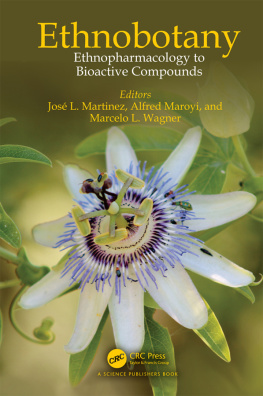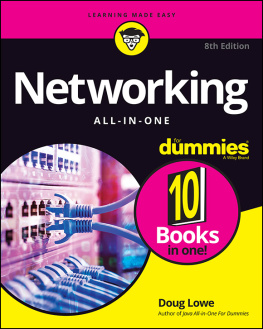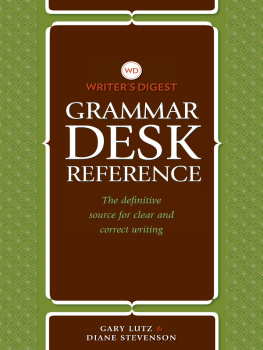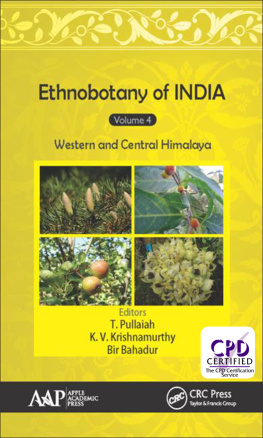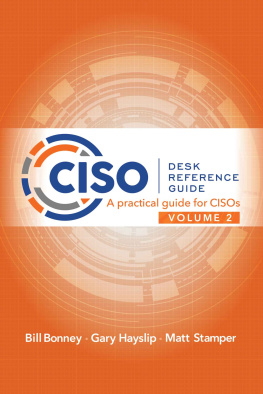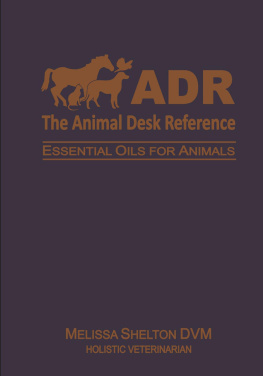Tim Johnson - CRC Ethnobotany Desk Reference
Here you can read online Tim Johnson - CRC Ethnobotany Desk Reference full text of the book (entire story) in english for free. Download pdf and epub, get meaning, cover and reviews about this ebook. year: 2017, publisher: CRC Press, genre: Detective and thriller. Description of the work, (preface) as well as reviews are available. Best literature library LitArk.com created for fans of good reading and offers a wide selection of genres:
Romance novel
Science fiction
Adventure
Detective
Science
History
Home and family
Prose
Art
Politics
Computer
Non-fiction
Religion
Business
Children
Humor
Choose a favorite category and find really read worthwhile books. Enjoy immersion in the world of imagination, feel the emotions of the characters or learn something new for yourself, make an fascinating discovery.

- Book:CRC Ethnobotany Desk Reference
- Author:
- Publisher:CRC Press
- Genre:
- Year:2017
- Rating:5 / 5
- Favourites:Add to favourites
- Your mark:
- 100
- 1
- 2
- 3
- 4
- 5
CRC Ethnobotany Desk Reference: summary, description and annotation
We offer to read an annotation, description, summary or preface (depends on what the author of the book "CRC Ethnobotany Desk Reference" wrote himself). If you haven't found the necessary information about the book — write in the comments, we will try to find it.
Tim Johnson: author's other books
Who wrote CRC Ethnobotany Desk Reference? Find out the surname, the name of the author of the book and a list of all author's works by series.
CRC Ethnobotany Desk Reference — read online for free the complete book (whole text) full work
Below is the text of the book, divided by pages. System saving the place of the last page read, allows you to conveniently read the book "CRC Ethnobotany Desk Reference" online for free, without having to search again every time where you left off. Put a bookmark, and you can go to the page where you finished reading at any time.
Font size:
Interval:
Bookmark:
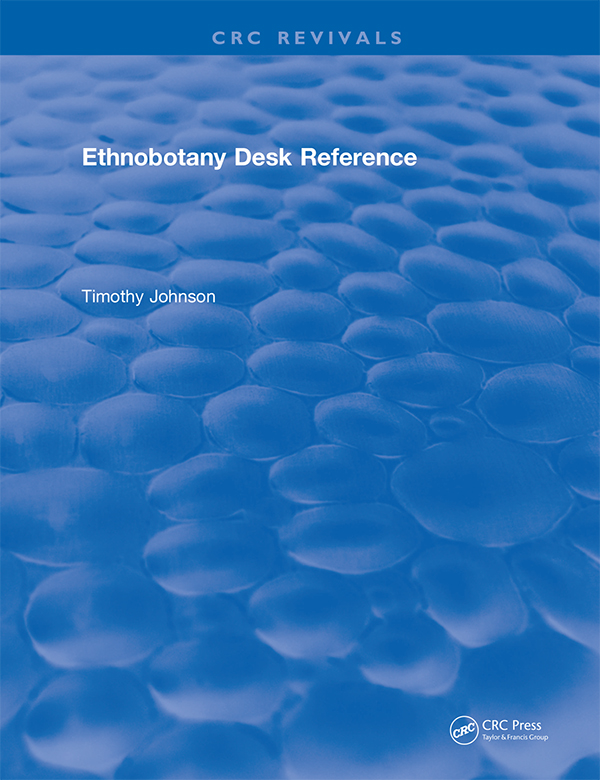
First published 1999 by CRC Press
Taylor & Francis Group
6000 Broken Sound Parkway NW, Suite 300
Boca Raton, FL 33487-2742
Reissued 2018 by CRC Press
1999 CRC Press, LLC
CRC Press is an imprint of Taylor & Francis Group, an Informa business
No claim to original U.S. Government works
This book contains information obtained from authentic and highly regarded sources. Reasonable efforts have been made to publish reliable data and information, but the author and publisher cannot assume responsibility for the validity of all materials or the consequences of their use. The authors and publishers have attempted to trace the copyright holders of all material reproduced in this publication and apologize to copyright holders if permission to publish in this form has not been obtained. If any copyright material has not been acknowledged please write and let us know so we may rectify in any future reprint.
Except as permitted under U.S. Copyright Law, no part of this book may be reprinted, reproduced, transmitted, or utilized in any form by any electronic, mechanical, or other means, now known or hereafter invented, including photocopying, microfilming, and recording, or in any information storage or retrieval system, without written permission from the publishers.
For permission to photocopy or use material electronically from this work, please access www.copyright.com (http://www.copyright.com/) or contact the Copyright Clearance Center, Inc. (CCC), 222 Rosewood Drive, Danvers, MA 01923, 978-750-8400. CCC is a not-for-profit organization that provides licenses and registration for a variety of users. For organizations that have been granted a photocopy license by the CCC, a separate system of payment has been arranged.
Trademark Notice: Product or corporate names may be trademarks or registered trademarks, and are used only for identification and explanation without intent to infringe.
Johnson, Timothy.
CRC ethnobotany desk reference / Timothy Johnson.
p. cm.
Includes bibliographical references and index.
ISBN 0-8493-1187-X (alk. paper)
1. Ethnobotany--Handbooks, manuals, etc. 2. Materia medics, Vegetable--Handbooks, manuals, etc. 3. Botany--Handbooks, manuals,
etc. I. Title.
GN476.73.J66 1998
581.63dc21
98-40036
A Library of Congress record exists under LC control number: 98040036
Publishers Note
The publisher has gone to great lengths to ensure the quality of this reprint but points out that some imperfections in the original copies may be apparent.
Disclaimer
The publisher has made every effort to trace copyright holders and welcomes correspondence from those they have been unable to contact.
ISBN 13: 978-1-315-89184-2 (hbk)
ISBN 13: 978-1-351-07094-2 (ebk)
Visit the Taylor & Francis Web site at http://www.taylorandfrancis.com and the CRC Press Web site at http://www.crcpress.com
A large number of the trees forming these forests are still unknown to science, and yet Indians, these practical botanists and zoologists, are well acquainted, not only with their external appearance, but also with their various properties. It would greatly contribute to the progress of science if a systematic record were made of all information thus scattered throughout the land; an encyclopedia of the woods, as it were, taken down from the tribes which inhabit them.
Professor and Mrs. Louis Agassiz (1868)
This work results from a fairly old idea - gathering information about plants and their various properties and uses, to create a reference book. Many of the old herbals are based upon even older herbals, and represent regional beliefs about regionally available plants and their uses. The writer of an herbal gathers all of the available information and compiles it into a larger whole. The difference, in this case, is the subsequent invention of the personal computer, the database, and the internet. Now it is possible to create an herbal of much greater scope. There is a vast amount of available information. Herbal guides have always been arranged in a standard way - the species, common names, uses, illnesses the plant is used to treat, the parts of the body the plant is associated with, and the action the plant takes upon the body. Herbal guides contain information that can be broken down like this:
Achillea millefolum is used to treat headaches.
Yarrow is a common name for Achillea millefolium.
Achillea millefolium grows in California.
The same information stored in a database looks like this:

This data structure can be sorted either by plant or by property. This database contains information on the following plant properties:

This database grew steadily during a six-year period. At first, I typed in the plant properties mentioned in various books, which yielded information about some 800 species. Later, I gathered information that was already digitized and stored in several U.S. government databases. This made it possible to expand the scope to over 28,000 species, and in doing so, to yield a clearer picture about each individual species.
The database says that a carrot (#8390) is an antiseptic, aperient, aphrodisiac, blood cleanser, carminative, cathartic, deobstruent, diuretic, entheogen, nervine, stimulant, stomachic, tonic, and vermifuge. These properties dont all correspond to the part of the carrot we are the most familiar with - the root. The leaves are the entheogenic part, and it is a leaf tea that is antiseptic. The root, when eaten raw, is a good stomachic - mostly because it is fairly rough and sharp, and its action is to unclog your innards as it passes through the digestive system. A carrot also contains numerous ingredients - the most famous of which is vitamin A. We know a lot about carrots because they are tasty, and easy to grow, and you can grow them almost anywhere, and theyre good for you. Carrots are well known, yet there is much we do not know about carrots. In California, when I was growing up, I thought that carrots came from the grocery store. It took me a while to become cognizant that they grew in the ground, and even longer to realize that there was more to a carrot that just the root, and more than one kind of carrot. You could spend your whole life checking out carrots, and never get to the bottom of it. There is much to learn - hopefully this book will provide some clues.
The primary inspiration for this research was the loss of biodiversity that I have personally experienced. I grew up in a suburb of San Francisco that was mostly orchards and backwoods, and I watched the human population grow into what is now known as the Silicon Valley. No more orchards, and not so much backwoods as before. Every year the population grows. Some of the old mountain paths were paved over, and the adjacent land is strained. Habitats were disrupted in the local food chain. What you see today is not necessarily repairable. It was my intent to find out something about what is being lost.

Timothy Johnson is a technical consultant specializing in information architecture. His clients include many Fortune 500 companies in finance, communications, and computer software. He founded herbweb.com in 1992, an herb information site that has won several prestigious awards for its content and design.
Font size:
Interval:
Bookmark:
Similar books «CRC Ethnobotany Desk Reference»
Look at similar books to CRC Ethnobotany Desk Reference. We have selected literature similar in name and meaning in the hope of providing readers with more options to find new, interesting, not yet read works.
Discussion, reviews of the book CRC Ethnobotany Desk Reference and just readers' own opinions. Leave your comments, write what you think about the work, its meaning or the main characters. Specify what exactly you liked and what you didn't like, and why you think so.

